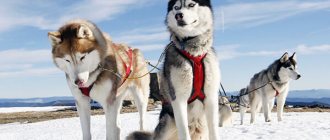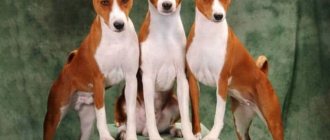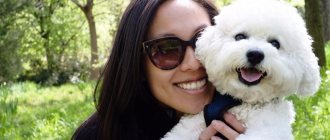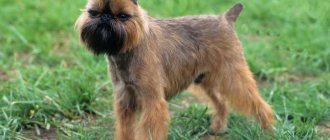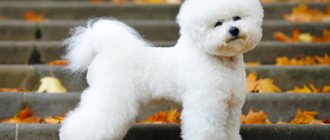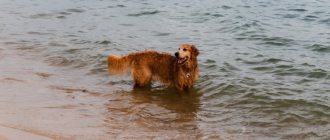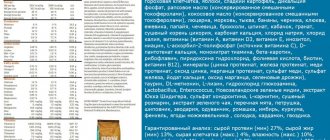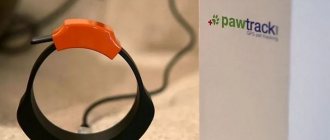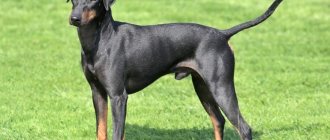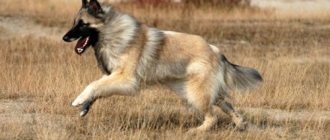The Bichon Frize or French lapdog is a small decorative dog that resembles a plush toy, which is characterized by the following features:
- spectacular appearance;
- fluffy curly white fur;
- friendly disposition;
- loyal attitude towards children;
- attachment to the owner;
- desire to always be in the center of attention;
- demanding care;
- ability to adapt to different conditions.
The name Bichon Frize translates to "Curly lap dog" and is short for "barbichon" (small spaniel). The Bichon Frize dog breed actually comes from the Water Spaniel (Barbet) and the Poodle. Since there is reason to believe that its homeland is France, the pet that looks like a white cloud is also called the French lapdog. It was created to help hunters, but is used exclusively as decorative.
Pros and cons of the Bichon Frize
The advantages of Bichons are:
- They adapt well to apartment life. Contrary to popular belief, small dogs are not necessarily comfortable in apartments—some are too energetic to live in a high-rise building. But this does not apply to Bichons - they adapt well to apartment life;
- Suitable for first-time owners - they learn better and are quite friendly. They are also resilient enough to recover from mistakes or inconsistencies of their owners;
- Friendly to family, strangers and other dogs. They will always be happy to see their owners, and guests will be greeted with a wagging tail and a smile from ear to ear;
- They have curly hair that does not fall out (one of the best breeds for allergy sufferers).
The disadvantages of Bichons include the following:
They don't like to be left alone for long periods of time. An agitated dog can be very destructive, barking, whining, chewing and causing chaos. This breed does best when a family member is home during the day or if it is possible to take the dog to work; Care is required for them. You need to be prepared to pay for professional care. Highly motivated owners can learn the technique, but it is not easy and time consuming; Bichons tend to inherit a problematic immune system that makes them susceptible to allergies. They may be allergic to fleas, grass, pollen, certain shampoos, and so on. Allergies cause Bichon Frize to scratch and chew skin conditions; Bichons are smart and cunning
To make your pet the best companion, it is important to teach it obedience.
Advantages of the breed
- Spectacular appearance . Perhaps the breeders who developed the breed did not plan to make it so attractive, but biology has spoken, and there is no going back. Bichons are small dogs (their height does not exceed 30 cm ), so they fit perfectly, for example, in a bag. If a fluffy white cloud peeks out of a bag, anyone who looks at it will not be able to stop smiling. By the way, it will be difficult even for a person with allergies to keep from smiling: the structure of Bichon hair is much closer to human hair, so allergy sufferers can tolerate their presence much easier.
- Friendly character . Although Bichons, like all dogs, will always choose one person to whom they become more attached than others, they do not have problems communicating with other family members. Although these dogs are small, their skeleton is strong enough, so it is not dangerous to play with them - even a puppy is very difficult to injure. They react positively to children, play with them and will never open their mouths on them. This also applies to communication with other animals. Of course, a friendly dog will be a bad watchdog, but not all dogs protect the house, right? Someone just needs some eye candy!
- Intelligence and flexibility . Bichons are very easy to raise and train, so even those who have no previous experience with dogs can adopt them. The breed is very easy to train and even truly enjoys it.
- Health . Unlike many other dwarf breeds, the Bichon's body is very strong and steadfastly resists diseases that often affect other dogs. As a result, the pet lives longer and pleases its owners longer. However, they are still susceptible to some diseases, but their risk can be reduced by monitoring the dog's diet and carefully taking care of its appearance (which will be discussed in detail later).
- Fast adaptation . The only quality of a hunting dog that Bichons still possess is their rapid adaptability to any conditions. It doesn’t matter whether the dog lives in cold or heat, he will definitely endure it and won’t bark a word against it. Being immune to temperature changes also means that your dog won't have to buy extra clothing for the winter.
- Undemanding to walking . Unlike many active dogs, Bichons feel great at home - even in city apartments. They do not need to be walked every day, and some owners even note that their pets go to the litter box without any problems, like cats.
- They don't shed . Just imagine, something like this happens: the fur is not only beautiful and fluffy, but the dog also doesn’t scatter it all over the house! This means that owners do not have to run after their pets and endlessly clean up after them. However, this advantage is devalued given the fact that Bichons require regular haircuts - and these can be much more expensive than regular cleaning of the premises.
Description and features
Many dog breeders underestimate lap dogs. They believe that this group is decorative, indoor dogs that are pointless to use in the household. But no! The Bichon Frize breed is an excellent hunter, but rather a rat catcher. But in order for a dog to perform such tasks, it must be trained correctly.
It is believed that the breed was developed back in the 13th century by crossing a water spaniel with a poodle. The Bichon Frize accompanied ships for many centuries. The sailors of that time had a superstition: not taking such a dog with you would mean losing the voyage.
People believed that the good-natured and charming creature would save them from harm. Lapdogs truly have a charm that is unique to them. They are good-natured, cheerful and loving.
It is believed that the homeland of this breed is France. Their name literally translates as “curly lapdog” (from French bichon - lapdog, frisé - curly, curly). It fully corresponds to the appearance of animals, which are characterized by miniature size and exterior parameters.
This little Bichon Frize will make any family that adopts him happy! He is very fond of people and most representatives of the animal world. We can say that such a dog is an ideal pet.
It does not require large investments and is completely unpretentious in maintenance. The main need of such a dog is human love. She needs regular expressions of tenderness and affection. Without this, he falls into a state of stress and deep depression.
Lapses are often used as companions. These cute and small dogs do not like it when their owners are upset about something. They try their best to cheer them up. They are friendly to strangers only if they feel that the owner is not against their presence in the house. By the way, they read emotions perfectly.
The Bichon Frize dog is active and cheerful. She can fall asleep in broad daylight only if she is very tired beforehand. The dog will prefer fun outdoor games to a lazy lifestyle.
He loves being in big company! The arrival of guests to the house will certainly make him happy, especially if there are kids among them. The lapdog is especially loyal to them. She likes loud children's laughter, pranks and games. She will never harm a child, even if he accidentally hurts her.
The breed is very peaceful and kind. Conflicts greatly upset the dog, so he never provokes them with anyone in the house or outside it. But, well-developed intuition can push a dog into aggression towards a person. In this case, she will bark and even bite the suspicious stranger.
Disadvantages of the breed
- Increased demand for attention . This may not be a disadvantage for some, but if you are not ready to devote all your free time to the dog, you may have problems with a Bichon. This is a very loving breed that enjoys being with people even when they are busy or not in the mood to interact with the dog.
- White wool gets dirty easily . White is the most innocent color, which can be easily stained. Even if the dog itself does not require constant walking, access to fresh air may be necessary for the owner himself - for example, older people who have pets, so that they have an incentive to go outside regularly. The problem is that if it is dirty outside, if the weather is very bad, the white coat will quickly become dirty, and you will have to spend time washing the dog. But this may already be problematic. If the coat is not taken care of, it can begin to darken, so owners regularly remove dirty spots from the Bichon's coat using tampons, cotton wool and napkins.
- The coat and eyes need to be looked after . Many people think that if Bichons do not need to be walked for several hours a day, then a dog of this breed is easy to handle. No matter how it is! The Bichon will still require a lot of time spent on him - even while doing other things. In fact, dogs of this breed need someone to care for their coat - brushing it regularly, washing it every two weeks, and cutting it every few months. Otherwise, the beautiful fur begins to fall into clumps, and the beautiful pet loses its attractive appearance.
- Expensive haircuts . And, of course, you shouldn’t cut a dog’s hair yourself without proper experience. It is advisable to take her to the dog groomer once every few months. Several haircuts, not cheap and one at a time, together can result in a round sum, which not every owner can find. Remember that hair growing near the sensory organs - ears, eyes - can cause diseases associated with these organs.
- They can bark very loudly . Bichons have a very ringing and loud voice, so they can cause meaningless noise in the apartment. It doesn’t matter whether the dogs are trying to attract attention, whether they are trying to play with the owner or scare away an uninvited guest passing behind the door - sometimes it becomes annoying. Of course, a dog can be weaned from violent reactions, but this is a matter of quality education, which few owners succeed in.
How to name
The question of a name is problematic for some owners, since not all nicknames correspond to the appearance of the Bichon Frize.
Names for boys:
- Adik;
- Brutus;
- Jasper;
- Star;
- Harley;
- Fluff;
- Snowball;
- Charlie.
Names for girls:
- Aika;
- Snowstorm;
- Naida;
- Saiga;
- Grace;
- Delphi;
- Comet;
- Yula.
Potential breeders thinking about purchasing a French lap dog need to understand that this breed requires a significant financial investment. Care must be carried out regularly, this takes a lot of time. You shouldn't get a dog just because of its appearance. She has a unique character and habits that not all owners can get used to.
How to choose a lapdog puppy
Photo: https://www.flickr.com/photos/optictopic/8659917666/
In order for your puppy to be healthy and happy for many years, you need to choose your pet very carefully. Private nurseries will help in this matter, where very close attention is paid to both the mother of the puppies and themselves.
There are usually not many puppies born in a litter.
You should not believe advertisements that guarantee the purchase of a purebred baby at a low cost.
It is impossible to purchase a purebred Bichon Frize on the market. At best, they can slip you a snow-white poodle or mixed breed.
If you need a French lapdog, it is better to hire a specialist who knows the standard and all the intricacies of the breed.
It is recommended to study reviews about the nursery in advance, meet the owner personally and all the documents. Only after this you can start choosing a puppy.
Not only the appearance of small bichons is important, but also their behavior.
You should not buy shy kids or, conversely, overly aggressive ones. The Bichon you choose must be flawless in appearance, clean and well-groomed. The presence of discharge from the eyes, bald spots on the skin, wounds, and abrasions is unacceptable. Dull fur is also a sign of poor health.
You can take a puppy into your home only when it has reached the age of 2.5-3 months. If you need a show dog and plan to shine on the catwalks in the future, it is better to choose a mature puppy. Then you will be able to see with your own eyes the snow-whiteness and quality of the baby’s fur, monitor the change of teeth and notice whether the testicles have descended into the scrotum of the little male dog.
Caring for a Bichon
Dogs of this breed require regular care, which will require not only time, but also material costs.
Grooming
Breeders recommend brushing your dog every day or at least 2-3 times a week, since the soft fur is prone to tangling and matting. Combs with rare and frequent teeth are used. The Bichon's coat grows constantly, which means that the dog will have to be cut every 1.5-2 months. A little more often a haircut will be required in the anus and genital area.
In life, Bichons very rarely look like the photos on the Internet - a round white cloud, because this requires considerable daily effort, special tools and professional cosmetics.
Water treatments are recommended every 2-3 weeks, but you can bathe more often, because soiled snow-white fur does not have self-cleaning properties. Shampoos are selected specialized for a given type of coat or breed. After washing and rinsing, use balms and conditioners to prevent tangling. The fur must be dried with a hairdryer. Dry shampoos can sometimes be used instead of washing.
Hygiene of eyes, ears, mouth and nail trimming
The eyes of Bichons must be regularly wiped from dirt using cotton-gauze swabs and special lotions. It is necessary to keep the tear ducts clean and dry, where the coat becomes brownish without proper care. To prevent the appearance of dark spots, you need to make sure that hairs and eyelashes do not get into your eyes. These factors, together with poor nutrition, often cause excessive tearing and further coloration of the coat. To lighten tear ducts, use veterinary lightening agents or 3% hydrogen peroxide.
The ears are regularly inspected for signs of infection or contamination. Clean as needed, about once a week. Teeth are brushed at least 2-3 times a week, especially if the dog eats natural products or soft commercial food. Regular hygiene will prevent plaque from forming and will prevent tartar. If the claws do not have time to grind down on their own, they are trimmed with pruning shears about once a month.
Care and maintenance
Clipped Bichon Frize
The Bichon Frize is not a breed you can afford to be a little lazy with. Despite the fact that French lap dogs practically do not shed, their lush coat requires careful care. It is necessary to comb the animal every day (preferably after walks, to remove debris and grains of sand entangled in the fur), and also use a slicker brush to make the “fur coat” airier.
If a pet comes from the street, its paws, face and genitals are usually washed. French lap dogs are supposed to be bathed once a month. When washing, be sure to use a mild shampoo and conditioner to make the coat easier to comb. It is advisable to visit a groomer once every 2-3 months. However, if you are not raising a show-class animal, you can save a little on grooming and cut the animal’s hair yourself.
The Bichon Frize's eyes should be checked every day and, if necessary, cleaned with a cotton swab dipped in cool, boiled water. The same rule applies to keeping your ears clean. Bichons' nails are trimmed twice a month with a nail clipper or tweezers. The unevenness of the claw plate formed after the procedure is filed down. Teeth and mouth should be cleaned using special toothpaste at least once a week.
Feeding
Feeding your French lapdog with natural products, preferring a combined feeding option or limiting yourself to dry food is a question that each owner decides in his own way. Among the obligatory “dishes” that must be present in the diet of a “dandelion dog”, it is worth mentioning raw meat (to soften the product, you can lightly pour boiling water over it), boiled and raw vegetables, sea fish, from which the seeds have been previously removed, brewed buckwheat and oatmeal cereals Since adult Bichon Frizes are fed twice a day, it is better to give them meat with their evening meal and in thoroughly chopped form (it is very desirable that it is not pork).
Kus
Including milk in the Bichon menu is permissible only for puppies. For adults, a small amount of any fermented milk drink once a week is enough. It is highly not recommended to treat your pet with fatty, spicy and salty delicacies. Sweets, sausage, pastries, pasta, legumes and potatoes are also strictly prohibited, not to mention meat and chicken bones.
Individuals on natural feeding are advised to take vitamin complexes. Be sure to make sure that these are not preparations based on carrot and algae extracts, which are usually brightly pigmented and can noticeably change the color of your pet’s coat.
French lapdog puppies are fed 5-6 times a day. As the dog gets older, the frequency of feedings decreases, and by 9 months the animal completely switches to “adult” meals twice a day.
Toilet
Playful bichon
Bichon Frizes are quite active in resisting such science as using the outdoor toilet. At first, take your pet for walks more often: puppies - every half hour, adults - once every 2 hours. This way he will form a clear associative series: walk - toilet.
The optimal time for walking a Bichon for the purpose of toileting is considered to be the time after the dog has eaten (after 10-15 minutes). For particularly stubborn “comrades” who categorically do not want to use going outside to perform their needs and prefer to dirty the floor and carpet, another compromise can be found. In such cases, the dog is taught to walk on a newspaper or disposable diaper spread on the floor (the method is not suitable for males).
Cell
Playful and restless lap dogs can create an epic mess in the apartment, so sometimes Bichon owners have to resort to the services of a crate. This is an extreme but effective measure, designed for cases when there is no one to look after the pet. It is necessary to accustom a dog to a crate from an early age so that the animal does not view this restriction of freedom as a type of punishment.
External characteristics of the puppy
French lapdog puppies can become excellent friends for small children without taking liberties in their direction that other decorative dogs allow themselves. It is necessary to purchase a puppy only from trusted breeders after meeting the parents and checking their veterinary documents.
Attention should also be paid to the conditions in which the puppies are kept. Among the Bichon babies, you need to choose one who does not look sick, does not show excessive cowardice, or, conversely, behaves aggressively
You can consult with breeders on the subject of nutrition and care for lap dogs.
Height
Miniature lapdogs that have just been born have a height of 10 to 15 cm. You can find out what height and weight a French lapdog puppy will have upon reaching maturity by analyzing the external data of its parents.
Color, wool
From birth, Bichon's coat is white and has the characteristic curliness of the breed. However, sometimes puppies may show defects in the form of small yellow spots, which usually disappear as they grow.
Ears, tail
The ears and tails of French lapdog puppies cannot be cropped. Caring for your puppy’s drooping ears should begin as early as one month of age.
The average life expectancy of French lap dogs is from 12 to 15 years. There are cases where Bichons lived up to 19 years. If the dog is provided with proper care, then throughout the years of its life it will not cause much trouble to its owner, since the lapdog is not predisposed to genetic diseases.
Vaccinations, anti-worming treatments
The choice of vaccine depends on the epidemiological situation in the region and the veterinarian. Pathogenic microorganisms and viruses constantly mutate. Therefore, vaccination should be carried out with drugs that are most effective against pathogens present in a given region.
Puppies born from vaccinated bitches have maternal antibodies. This is why it is so important to check the mother’s veterinary passport when purchasing. But as the baby grows up, he loses some of these antibodies. By 2–3 months their number approaches zero. Therefore, vaccination begins at 6–8 weeks. Revaccination is carried out at intervals of 2–4 weeks.
Bichons are more often vaccinated with the French vaccine and the Dutch Nobivak series. The vaccination regimen is chosen by the doctor. Each vaccine has instructions for use. Using multicomponent drugs, you can build a step-by-step scheme that will protect your pet from plague, hepatitis, parvovirosis, parainfluenza, leptospirosis, rabies (Nobivak labeled DHPPi+LR).
It is important to protect your pet from parasites. Anthelmintic drugs are given before vaccination. For ticks and fleas, you can use drops on the withers (they do not spoil the coat) or wear a special collar.
What to feed Bichon Frize dogs
The average weight of a lap dog is 5 kg. Based on this, inactive and older animals should receive 300-500 calories per day, but active Bichons should receive 404-660 calories. Puppies should be fed more frequently and in a balanced manner during the first year of life. There are products labeled for different stages of a dog's life: puppy and adult. They contain the correct ingredients and calories for the designated steps.
It is recommended to divide the daily diet of an adult Bichon into two portions and feed it in the morning and evening. Puppies have three meals a day. This will allow your lapdog to eat small meals and also control her appetite. Canned and dry food is essential for the health of dogs. Its crunchy texture will help scrape plaque off your pet's teeth. Canned food does not provide the same cleansing benefits, but contains water
Its quantity is important for the Bichon, because the dog is susceptible to developing urolithiasis
Canned food and dry food can be mixed. When combining products, be sure to calculate their total calorie content. The lap dog's diet should include protein found in poultry, fish and beef. Whole grains such as barley, buckwheat, oats and brown rice will provide your dog with fiber and carbohydrates. They are easily digestible. Products containing vegetable and fish oils will be natural sources of fats and omega-3 fatty acids. They will help maintain thick fur, and also give it shine and softness.
Bichon Frize: history of the origin of the species
Snow-white Bichon
Today it is difficult to say exactly when the Bichon dog breed was developed. But it is known for sure that already in the thirteenth and fourteenth centuries they were used on ships transporting cargo across the Mediterranean Sea.
It is assumed that the birthplace of the breed is Greece. Local sailors transported cargo over vast distances. Of course, rats, which appeared on almost every ship, caused them a lot of trouble, spoiling provisions and in general everything they could reach. The sailors needed a reliable assistant and they became a Bichon Frize - a dog that copes well with the role of killing rats.
Soon sailors of other European powers - Spain, Italy, France - adopted this experience.
And then aristocrats paid attention to dwarf dogs - fluffy, white and miniature, they were perfect for the role of pets. Therefore, very soon French breeders began to develop a single standard
This is how the French Bichon appeared, as every dog lover knows today.
For reference! From French, the name “Bichon Frize” is translated as “fluffy lapdog.” But the Bishop or Bouchon dog does not exist in nature.
Origin of the Bichon Frize breed
The Bichon Frize dog breed has aristocratic roots. It appeared several centuries ago, presumably in France. However, another country claims to be the historical homeland of the Bichon - Belgium. “Curly-haired lapdog” is exactly how the name of the breed is translated from French.
It is believed that the breed originated from the Tenerife lapdogs, common during the Renaissance. Their purpose was to catch rats. According to other versions, the ancestors of modern bichons are water spaniels.
In the 15th century, they were favorites of French aristocrats and were considered desirable pets in noble houses of Spain, Italy, and England. Thus, King Henry III adored curly lap dogs and never parted with them.
The breed's popularity faded during the reign of Napoleon III. Curly-haired lap dogs also appeared in the homes of ordinary people. For many decades they were forgotten and on the verge of extinction. Only at the beginning of the 20th century did dog handlers become interested in the breed again.
In 1933, the French Kennel Club approved the Bichon Frize breed standard. In the United States, curly lap dogs were recognized two decades later, but bichons were only allowed to participate in AKC shows in the early 70s of the 20th century.
Breed diseases of Bichon
The breed is in good health. Hereditary diseases are identified even in puppyhood by breeders who take measures and prevent the spread of defects. Before buying a puppy, you should familiarize yourself with its heredity. Most often, Bichons suffer from the following diseases:
- allergies;
- retinal atrophy and cataracts;
- improper eyelash growth;
- epilepsy;
- hemophilia;
- dislocations;
- tartar;
- dermatitis;
- kidney diseases;
- heart problems.
It is necessary to regularly inspect the animal's mouth. A healthy dog has pink gums and white teeth. Brown plaque on the teeth and swollen red gums indicate tartar, which requires a visit to the veterinarian.
Please remember that Bichons are very sensitive to vaccines. If after vaccination your dog appears lethargic, develops a rash, or loses his appetite, you should immediately call a veterinarian. These are the first symptoms of an allergic reaction, which can lead to undesirable consequences, including death.
Lifespan
Due to their good health, representatives of the Bichon Frize breed are considered long-lived compared to their relatives. They live 15-18 years, sometimes living up to 20 years. They usually die from old age, and not from serious illnesses.
Description of Bichon Frize
Bichon Frize belong to the category of fairly small dogs, whose maximum height does not exceed 28-30 cm. The coat of a dog of this breed is quite abundant, up to 100 mm long, curly, soft and silky. The color features are established by standards, so the coat color can be exclusively white, but puppies are allowed to have beige spots that disappear with age. The skin is pigmented. Characterized by the presence of a black nose and dark rims around the eyes.
French standards require cutting a dog of this breed exclusively for hygienic purposes, as well as trimming the hair on the paws and face, which allows you to evaluate the overall length, volume and structure of the coat. In other countries, including Russia and America, it is quite acceptable to cut the Bichon Frize, during which the hair on the body is trimmed quite tightly, and a characteristic “mane” is formed in the neck area.
Breed standards
In accordance with the established standards FCI No. 215, the Bichon Frize breed belongs to the decorative dogs and companion dogs:
- the skull is quite flat, but thanks to the hair it has a rounded appearance;
- the hollow located between the brow ridges appears slightly;
- the stop is not too marked;
- the nose is round in shape, covered with delicate and shiny black skin;
- the muzzle area is shorter than the cranial part, not massive and not narrowed;
- lips are quite dry, thin, not thick, black;
- the cheekbone area is not too muscular, flat;
- the bite is normal, with the incisors of the lower jaw located closely;
- the eyes are dark in color, closer to a round shape, lively, but not very large and not protruding;
- ears of the hanging type, with the presence of gracefully curled and long hairs;
- the area is quite long, proudly and highly set, graceful and rounded in shape near the skull, with a gradual expansion smoothly entering the shoulders;
- withers not too emphasized, turning into a straight top line;
- straight back, muscular and strong;
- the loin is slightly arched, muscular and wide;
- the croup area is slightly rounded and moderately sloping;
- the chest is well developed and pronounced, with rounded false ribs;
- the belly and underline are well tucked, not drooping, giving a greyhound-like appearance;
- tail set slightly low relative to the dorsal line, carried erect, gracefully curved in line with the spine, but without forming a ring;
- the forelimbs in front are vertical and straight, with thin bones;
- the shoulder area is quite oblique, not convex and not extending away from the body;
- the croup is quite wide, with broad and muscular, sloping hips;
- the paws are strong and round, cat-type, directed forward, with black pads, strong and short claws.
The dog's movements at the trot are light and free, linear and coordinated, maintaining a straight topline and holding the head high. An increase in the speed of movement of the limbs causes them to approach the center line.
Dog character
The Bichon Frize has a naturally cheerful and playful disposition. This is a very active and courageous, but completely non-aggressive breed with a rather complex character. However, small white dogs are able to easily find a common language with their owner, and are also quite easy to train in almost any type of training.
Lifespan
The average life expectancy of a Bichon Frize breed pet varies between twelve and fifteen years, but only under conditions of proper maintenance and proper care.
How to care for such a pet
Feeding a Bichon Frize is one of the important points of caring for the health of this animal. The attractiveness of the pet’s appearance and health depend on this aspect. The Bichon Frize's diet differs in its individuality. For some dogs, only standard type natural food is acceptable and they like it that way. For others, consuming one of the products may lead to allergic reactions such as dandruff. It is better for such animals to be offered commercial food or to strictly select food items from the diet.
You can choose food for your pet only by the method of elimination, determining which foods are undesirable for it. The selection of dry food for Bichon Frize must be carried out in accordance with the requirements of this breed. These animals are small, long-haired dogs. Give your pet care, watch the diet and appearance of the handsome man. In return, he will delight you with manifestations of devotion.
External differences
The dogs look like toys, they are spectacular and cute.
The color is boiling white; puppies have red spots that disappear with age. Wool with waves, soft to the touch, resembles cotton wool. The Bichon dog breed is small in size: its height is no more than 30 cm, and its weight ranges from 3 to 5 kg.
The muzzle is not elongated, with a rounded nose and pronounced nostrils. The shape of the body depends on the haircut. The eyes are round, black, with the same color edging, and look like beads.
The dogs are distinguished by their proportional build, strong muscle and bone structure, which is inherent in the body of large dog breeds. When moving, they hold their head and neck high, and their back line is straight. This gives grace, lightness and elegance.
Bichon Frize - description of the breed
This companion dog is a decorative dog. She has a proud posture and snow-white fur. With a small body size, the French lapdog is a long-liver that can live up to 15 years. The dog's character is good-natured and playful without any aggression. Bichons easily become attached to their owners and try to stay close to them as much as possible. Many people have the misconception that this breed is stupid, but this is not the case. Their intelligence is above average. Dogs can be trained without any problems.
History of the Bichon Frize breed
According to one of the popular versions of the appearance of these dogs, their homeland is the Canary Islands. Local fishermen took these small dogs to protect food from rats and easily sold them while traveling to other countries. The population was divided into: Maltese, Tenerife and Hawaiian. The first name was “Barbie-chon”, when the breed was officially registered, what remained was “bichons” in translation meaning “curly-haired lapdog”. The breed received its modern appearance in the 14th century. The palace ladies liked it so much that they forgot about the role of the rat catchers. Until now, the Bichon Frize dog has not gone out of fashion.
Standard Bichon Frize
The current parameters appeared in 1988. A distinctive feature of the breed is its great curliness. With such an airy appearance, dogs have a very strong constitution. The description of the Bichon Frize standard includes the following characteristics:
- height – 30 cm;
- weight – about 5 kg;
- the head is slightly elongated;
- forehead is flat;
- hanging ears of medium length;
- nose is large and dark in color;
- round black eyes;
- teeth are straight;
- the body is rectangular;
- The sternum and back are wide;
- limbs are strong;
- paws are rounded;
- the tail is raised and covered with long hair;
- The coat is long and curly, white in color.
https://youtube.com/watch?v=m81OmuQMwPg%250D
Bichon Frize - character
These dwarf dogs have a balanced and friendly disposition with a cheerful character. The Bichon Frize breed is a playful dog that loves people and other pets. Some owners are sure that they know how to smile, their faces are so friendly. In addition, the following character traits can be distinguished:
- love of walks and active games;
- ease of training;
- complete obedience to the owner;
- impatience with rude treatment;
- quick adaptation to any situation;
- bad qualities of a security guard, but in case of danger they will defend themselves.
Does the Bichon Frize shed or not?
Anyone who is unfamiliar with this animal is wondering whether there will be problems during molting, because the animal has a large amount of fur, and if it starts to climb, the apartment will be a complete mess. According to experienced dog breeders, the French lap dog does not shed, but the coat requires complex care, so to maintain an ideal appearance, it is recommended to seek the help of a professional groomer.
Varieties
Today, several breed subgroups have been identified, which include lapdogs with similar appearance and characteristics. They differ in the place of breeding and growth.
You can get acquainted with the varieties of Bichons in the table below.
Breed diversity
| Breed name | Short description | Peculiarity |
| Havanese (Havanese Bichon) | They have a lush coat, which can be either white or have various shades of brown, spotting is allowed. Representatives of the breed get along well with children and pets. | Highly people-oriented. If a dog is left alone for a long time, it will find entertainment in the form of damaging furniture, carpets, etc. Havanese is considered a rare breed in the Russian Federation |
| Bolognese dogs (Bolognese) | The short fur on the face becomes longer on the rest of the body. The dogs have a square-shaped body, unlike other Bichons. | The dog's complete inability to remain alone for more than a few hours. If the owner of the Bolognese leaves the house for a long time, then the neighbors will have to listen to the dog’s very loud protests expressed by barking or howling. |
| Maltese dogs (Maltese) | Belong to the decorative group. The coat is long and requires careful care from humans. Despite the lack of watchdog qualities, the Maltese will easily bark at a stranger, and may even bite him. | The lack of undercoat makes representatives of the breed desirable pets in the home of people with allergies. It is especially worth noting that Maltese dogs have diseases that are inherited. Just like other Bichons, they cannot stand being alone. |
| Levchens (lion dogs) | They are also lap dogs and have a friendly and affectionate character. Do not show aggression towards other pets | There are no genetic diseases. There is no shedding process as such in dogs. Taking care of the pet’s coat will take up quite a lot of the owner’s time, and periodic visits to the groomer are not a cheap pleasure |
| Coton de Tulear (Madagascar Bichon) | They are similar to Havanese, and breeding work on natives from Madagascar has not been completed to date | Ideal pets for families. The dogs are very attentive, playful, and vigilant. Perfectly adaptable both in an apartment and in a country house. Cotons require intensive socialization and appropriate training to avoid behavior problems. |
| Russian colored lapdogs | For this breed, the standard provides for any colors, with the exception of snow-white. The dog is very intelligent and clearly captures the mood of the owner | Activity and endurance allow the lapdog to take long walks with the owner. Thanks to its good adaptability to transportation, the dog will be able to go with a person on any trip. |
Brief historical background
According to some historical evidence dating back to the 13th-14th centuries, French bichons descended from a common ancestor for most lapdogs - a small white aboriginal dog that has long lived on the islands and the Mediterranean coast (its ancestor is considered to be water barbets). For purely practical purposes, local sailors took small dogs with them on sea ships - the dogs were excellent at catching rodents (mice and rats) in holds with provisions during long journeys. Having reached their destinations, the pets ran to land on their own, or they were gladly sold to local residents by sailors and merchants from ships.
The population brought to various regions gradually grew and divided into several lines: Italian, Havana, Maltese and Tenerife. The descendants of Tenerife are the modern Bichon Frize. The peak of the breed's popularity came during the Renaissance, when the European nobility kept lapdogs as exclusive and expensive pets. The French monarch Henry III had a special love for fluffy snow-white dogs, who took them with him to his bedroom, carried them in a wicker basket around his neck and did not part with his beloved dogs for a minute.
Small white dogs were a hit with the ladies of the court.
The French Revolution greatly shook the position of pampered ornamental animals. From the palace chambers they were forced to move to the streets of Paris and even to troupes of traveling circus performers. The number of French lap dogs has decreased greatly, they almost disappeared altogether. The breed was saved by Belgian dog handlers, who began its revival at the beginning of the 20th century. The first official breed standard was developed and adopted in 1933. A year later, the French Kennel Club approved this decision. The French lap dogs received their modern name - Bichon Frize - in 1978, at which time the breed was recognized as Franco-Belgian. In the 70s, French Bichons were recognized in England, Sweden and the USA. The latest currently valid standard was adopted on September 2, 2016. In the FCI registry, the Bichon Frize is listed in group 9 - companions and decorative dogs (section 1 - bichons and related breeds) under number 215.
A little history
The mission that falls to the lot of this little dog is to bring joy to the family, live in apartments, wear fashionable accessories and proudly accompany its owners. This is the way it is now, but if you look at history, you can see that in the 16th century everything was different. People did not have the opportunity to keep pets if they did not bring benefits with their work. The historical homeland of the Bichon Frize dog is the territory of the Canary Islands. Now it is an autonomous republic. It was here that large dogs lived, valuable to people due to their strength and endurance.
Due to the fact that rodents were destroying food, people taught small dogs the skills of hunters. For the ancestors of the modern lapdog, it was an honor to serve on a merchant ship, where they safely cleared the holds of mice and rats. The described rat-catching dogs had a white, curly, light-textured coat. Since the peculiarity of white color is the reflection of heat rays, this makes it possible to maintain body temperature.
Curly and light wool is well blown by the wind, but it is protected from moisture. And such properties contribute to the process of self-cooling. It is also noteworthy that in translation the Canary Islands are called the Dog Islands. The autonomy's coat of arms is decorated with two dogs. Sailors constantly managed to sell dogs when visiting other continents. Therefore, “curly hair” soon appeared in many countries.
King Francis I made such dogs a privilege for the nobility. The breed was named infant, which translated sounded like “prince.” Henry III also created a stir around Bichon Frize dogs, instructing his servants to make special carriers so that he could walk everywhere only with his dogs. Small dogs have achieved dizzying popularity thanks to a new fashion trend. Every self-respecting court lady or high-ranking official should have had such a four-legged friend.
Among the French, white curly dogs were especially valued. Today it is fashionable to carry small dogs in your arms, but in the times of kings it was customary to bathe with these animals, since the nobility were attacked by lice, fleas and bedbugs. Therefore, the first lap dogs had the mission of attracting parasites.
Tendency to diseases
Bichon Frizes live an average of 16 years, which is a record among toy dog breeds. They have good health, but get sick without proper care.
Possible diseases:
- diabetes;
- kidney pathologies;
- skin diseases;
- cataracts and other vision problems;
- dental diseases;
- joint dysplasia;
- allergy.
A dog owner can prevent many of these diseases through quality pet care and good nutrition.
Vaccination plays a big role, however, there are often cases when Bichons have allergic reactions to vaccinations (photos of a Bichon Frize with an allergy can be seen on the Internet).
Walking and exercise
In foreign nurseries, special open areas are built for walking Bichons. Our owners of white lumps face problems. After a walk on dusty asphalt, the fur coat loses its whiteness, and in slush and rain it can suffer greatly.
The best place for walking is a low lawn. There the baby can run around to his heart's content without spoiling the fur. In bad weather, you don’t have to take your pets outside at all. They quickly get used to the tray. But you can’t do without physical activity. A walk is not only an opportunity to solve physiological needs, but also communication, socialization, and physical development of the puppy.
Tendency to diseases, vaccinations
Pets have good health, but they are predisposed to the following diseases:
- diabetes;
- allergy;
- dermatitis;
- epilepsy;
- urolithiasis disease;
- atlantoaxial subluxation;
- dislocation of the kneecap;
- hypotrichosis;
- eye diseases (cataracts, corneal dystrophy);
- congenital deafness;
- inversion of the eyelids (entropion).
Pets may suffer from infectious diseases: enteritis of various etiologies, kennel cough (canine flu) and others. Many dangerous diseases can be avoided by wisely using vaccination.
Interesting facts about the Bichon Frize
The breed has a rather rich history and, in general, many interesting facts that every breeder will be interested to know:
- For a long time, snow-white dogs were the favorites of aristocrats in many countries of southern Europe.
- The French monarch Henry III, who lived at the end of the sixteenth century, had an unusual attachment to bichons - even when solving state issues, he did not part with his favorites, often hanging a basket with them around his neck.
- In the paintings of famous artists - Goya and Fragonard - you can see snow-white fluffy dogs, which a connoisseur will unmistakably recognize as French lap dogs.
So, if the reader has long dreamed of having a miniature, cheerful and beautiful dog, but has no experience in dog breeding, the Bichon Frize will be an excellent choice for him.
Meeting the aristocrats
The pronunciation of the name of the breed allows you to predict the country from which these dogs come. This is France. Here such a dog is called a lapdog with the addition of “curly”. Owning a snow-white “curly-haired cat” is ideal for apartment living, as it gives endless positivity to everyone around you.
What parameters of this breed are the disadvantages, according to reviews from Bichon Frize owners?
Education and training
The French lapdog is easy to train. It is necessary to teach basic commands and rules of behavior from an early age, otherwise the matured Bichon will be too capricious and difficult to control.
First of all, he is taught to use the tray, then the commands “place” and “no”. These dogs must be trained in a playful way without harsh words or punishment.
Bichons have an innate circus artistry and can learn quite complex tricks. Dogs of this breed can often be seen in circus arenas.
They are very loyal and obedient animals and do not seek to dominate relationships with their owner, which makes it easier to train them.
Despite the talent of these lap dogs, they should not be overly pampered and indulged in everything, otherwise this can lead to their uncontrollability.
During the training process, it is unacceptable to treat them rudely, and only treats and kind words can be used as encouragement.
Bichons are quite capricious animals that are quite easy to spoil. Insufficient education and permissiveness on the part of the owner can make this dog almost uncontrollable.
It is very important from the first months of the puppy’s arrival in the house to accustom it to restraint and knowledge of basic commands. Bichons require a lot of attention, and if they don’t have enough of it, they can cause a lot of trouble, both on the street (by pestering passers-by) and at home (by creating chaos and damaging furniture).
Bichons require a lot of attention, and if they don’t have enough of it, they can cause a lot of trouble, both on the street (by pestering passers-by) and at home (by creating chaos and damaging furniture).
It is necessary to approach training consistently and responsibly. Dogs sense the owner’s mood, and if he is persistent in training his pet, then the pet will be more patient and will be happy to carry out the commands required of him.
Standard for an adult Bichon Frize dog
The current standard appeared in 1988. A distinctive feature that has become characteristic of these dogs is curly hair. Here are more detailed characteristics that belong to this breed.
The head is proportional to the body, the forehead is flat. Round, dark eyes set straight. The muzzle is strong, shorter than the skull, the lips fit tightly to each other, the upper lip completely covers the lower one. The teeth are straight, scissor bite. The nose is round and black. The ears hang on the sides of the muzzle, are not very long, and are covered with hair.
Rectangular body. Straight, strong and wide back. The neck is flexible and rounded. The chest is well developed, wide and deep. The tail is located at the level of the spine, is of medium length, and covered with long hair.
The limbs are strong, with well-developed muscles. The front legs are parallel, set close to the body, rounded and dense, with black claws.
Important! The color can only be white!
Coat type and length. The coat of these dogs is very long, soft, silky to the touch, and constantly tends to curl into spiral curls. They have a fairly soft and thick undercoat, which protects them from sudden temperature changes.
The weight is the same for both males and females. These dogs weigh from three to five kilograms.
The size is different. For males it varies from twenty-five to thirty centimeters, for females - from twenty-three to twenty-nine centimeters.
Aristocratic features
- The Bichon Frize dog has a cheerful character, which is reflected in his gaze - lively and interested. The range of colors that distinguish the iris includes shades of dark brown with a tendency towards black.
- The eyelids fit tightly, completely hiding the whites and the area where the third eyelid is located. The pigmentation color of the eyelids is exclusively black, and the pigmentation of the skin around the eyes is brown with an almost imperceptible halo. This will be the distinctive feature that confirms the breed.
- The shape of the ears of these dogs is such that they hang down on the sides of the muzzle. But the ears cannot be called very long. They reach the middle of the skull. Their set is quite high, and the ears are decorated with light, elongated hair.
- Ear cartilage is elastic. In moments of alertness, they begin to rise at the base.
- Body parameters are distinguished by a rectangular format. The height of the animal is a quarter less than the length of the back, if you count from the shoulder blades to the croup.
- The neck is strong, flexible, rounded and makes up approximately one third of the body. There is a widening of the neck in the shoulder area and a smooth transition to the area of barely noticeable withers.
- The animal's back will be straight, proportionally wide, with a convexity in the area of the croup - short, moderately sloping, with a fairly smooth transition to the hind legs.
- The animal's chest is wide and deep with a rounded keel that protrudes forward when viewed from the side. The shape of the ribs is rounded, they are distinguished by their strength.
- The abdomen and groin are moderately tucked, without restricting confident movements, but also without drooping.
- The limbs are distinguished by their strength, good development of bones and muscles. The position of the front paws is parallel, they are close to the body with the elbows pressed to the chest.
- The location of the tail is marked level with the spine. It is thrown over the back and is distinguished by an abundance of long hair.
- The arrangement of the hind legs is parallel with the stifles and hocks jointed proportionally at an angle. The brushes are round in appearance, they are collected at a slight angle. The disadvantages of the Bichon Frize, according to reviews from owners, is the presence of dewclaws, which are recommended to be removed while still a puppy.
Dog character
Active dogs require a constant release of accumulated energy, so it is better not to get such a pet for passive people. You need to take your dog for regular walks and provide hygienic care.
Bichons hate being alone, so they suffer if their owner is often away from home.
If you do not train your dog and deprive it of attention, it will begin to damage property in the house. Bichons love to bark a lot
The dog is not suitable for lovers of peace and tranquility.
Representatives of the breed are cute and friendly. They get along well with children of any age and pets (with the exception of small rodents).
They easily adapt to new conditions, so moving to another area is unlikely to upset the Bichon.
Where to buy and price
The average cost of representatives of the breed is 60,000 rubles. Puppies offered for a noticeably low price should arouse suspicion. There is a risk of purchasing a non-purebred pet; dogs without documents can also be cheaper. The following nurseries enjoy a good reputation: Cameloia Bloom, Snow White Lamb, Cherche la Neige Renard.
If the owner can devote time to the dog and is attracted by the appearance of the charming Bichon Frize, he should definitely get a puppy. This white, fluffy little ball will surprise you with its devotion, love of life, and a host of other positive qualities.
Key facts
Loyalty, affectionateness, playfulness, mischief - these are the characteristics of the Bichon Frize breed. Reviews from the owners of French lap dogs speak about one thing: these mischievous little balls of fur win the hearts of people and make people smile with their touching seriousness. Photos, pictures, videos cannot convey the charm of these dogs.
The Bichon Frize is a companion dog, a little mischievous, smart, completely silent, and has the indescribable charm of a walking cloud. Responds to sonorous calls
She loves children, active walks and everyone's attention to her person. Occasionally, a dog may express indignation with a menacing growl or a demonstrative refusal to eat.
It is easy to train, but due to its character it can be undisciplined.
The dog practically does not shed, but the dense undercoat and white hair twisted into tight spirals requires careful grooming and daily combing. The description of the Bichon Frize breed explains that the dogs are hypoallergenic due to the absence of the characteristic dog odor and shedding.
Other names of the breed are used along with this one by the International Canine Association: French lapdog, curly-haired bichon.
The shortened name, "barbichon", comes from the merger of two French words "barbet" and "bichon". The dimensions of the Bichon Frize are miniature: weight in adult females and males ranges between 2.5 and 3 kg, height (height at the withers) is 25-30 cm. These values are typical for dogs in the “standard” category. Countries of origin: France and Belgium.
The lifespan of the Bichon Frize is long: they live approximately 12-15 years. The price for a dog starts from 30,000 rubles.
What does a French lapdog look like, what colors are characteristic of it? The Barbichon is a dog of a “dry” build, with an elongated muzzle tapering towards a black nose and playful black beady eyes. Often puppies are born cream colored and only become pure white by 12 months; No more than 10% of the cream “additive” is allowed in an adult.
Subtleties of choosing a pet
When choosing a baby, do not focus only on weight indicators. After all, all puppies of a small breed show activity during the growth period. Typically, breeders sell babies who have received the first few documents and basic vaccinations. At this point they are already more than 3 months old. It will not be surprising if the weight of such a toddler is up to 2 kg. The only real determinant of a dog's future size will be the size of its parents.
Compared to Toys and Yorkies, the Bichon Frize's miniature size is a disadvantage. Another important point is the size of the puppy’s head. But don't despair if your pet's head is disproportionately large in relation to the rest of his body. The last nuance is the color. It is acceptable to have a light peach “patina” that covers the muzzle and ears. In the process of growth, this feature will disappear.
Bichon Frize diet
The recommended daily amount of food for a Bichon Frize is 1/2 to 1.5 cups of high-quality dry food per day, divided into two meals. How much an adult dog needs to eat depends on its size, age, build, metabolism and activity level.
It is important to keep your Bichon in good shape by measuring his food and feeding it twice a day rather than leaving it out all the time. To check if your dog is overweight, you need to do a simple test:
To check if your dog is overweight, you need to do a simple test:
- Look at him from top to bottom. In this case, you need to see the dog’s waist;
- Place your hands on your back and walk your thumbs along the spine. In this case, you need to feel, but not see the pet's ribs, without pressing hard. If this fails, the Bichon needs less food and more exercise.
Bichons, like many small breeds, are prone to urolithiasis (stones in the urinary tract). Diet is an important part of treating and managing this condition. Therapeutic diets and increased water intake can help prevent and control this.
Health
This breed has a list of characteristic diseases, the most common of which is allergies. Usually, a predisposition to diseases is inherited and is easily calculated by breeders; further spread of the defect is not allowed. However, carefully study the heredity before purchasing a puppy. Among the most common diseases:
- hemophilia;
- retinal atrophy;
- heart problems;
- allergy;
- dislocations.
In cold or rainy seasons, it is necessary to dress your dog
Let's repeat and supplement our advice.
- Do not let your dog jump from heights or play with large dogs because there is a risk of dislocating his kneecap.
- You should carefully monitor the condition of the ears, teeth and claws.
- To avoid allergic reactions, feed the right food, no chicken or beef.
- In cold or rainy seasons, you need to dress your dog so that he does not freeze. Keep away from cigarette smoke. Some owners purchase a wardrobe that includes boots so that after a walk they do not have to wash their paws several times a day.
- Monitor your weight; sudden changes may indicate illness.
- Check your dog regularly for fleas and ticks and monitor its condition and body temperature. As spring approaches, the threat of catching an ixodid tick on a walk intensifies. Ticks, mosquitoes, midges and fleas carry a large number of diseases, including piroplasmosis, which can make your dog feel unwell. To prevent this from happening, treat your pet for ectoparasites once a month, applying the mixture between the shoulder blades.
Bichon Frize character
If your dog is bitten by a tick, take him to the veterinarian. There it will be removed, processed and tested.
